*This list of cyberbullying statistics from 2018-2024 is regularly updated with the latest facts, figures, and trends.
Internet connectivity is important because it provides both educational and social benefits for young people. Unfortunately, these positive attributes are counterbalanced by potentially dangerous consequences.
Alongside improving communication and democratizing access to information, the internet lets people conceal themselves behind a mask of anonymity. This creates a whole new set of risks for children – and often adults too.
The internet creates not only a threat for teens who could fall victim to cyberbullying – but also the potential for children to engage in online crimes, trolling, and cyberbullying themselves. That makes cyberbullying a topic that all parents and guardians need to be aware of.
Schools, governments, and independent organizations are attempting to raise awareness of cyberbullying and online stalking, but the cyberbullying statistics in this article illustrate that the problem is not going away anytime soon.
Cyberbullying around the world
In 2018, Ipsos surveyed adults in 28 countries, creating one of the largest-scale studies on cyberbullying to date. Unfortunately, it hasn’t repeated this survey since, but the old data is nonetheless eye-opening and informative.
In total 20,793 interviews were conducted between March 23 – April 6, 2018, among adults aged 18-64 in the US and Canada, and adults aged 16-64 in all other countries.
Of particular interest are Russia and Japan. In both countries, parents expressed extremely high levels of confidence that their children did not experience cyberbullying of any kind.
Meanwhile, Indian parents remained among the highest to express confidence that their children were cyberbullied at least sometimes, a number that only grew from 2011 to 2018. Across Europe and the Americas, it also appears more parents are either becoming aware of their children’s negative experiences with cyberbullying, or their children are increasingly experiencing such attacks online.
| Country | 2018 | 2016 | 2011 |
|---|---|---|---|
| India | 37 | 32 | 32 |
| Brazil | 29 | 19 | 20 |
| United States | 26 | 34 | 15 |
| Belgium | 25 | 13 | 12 |
| South Africa | 26 | 25 | 10 |
| Malaysia | 23 | -- | -- |
| Sweden | 23 | 20 | 14 |
| Canada | 20 | 17 | 18 |
| Turkey | 20 | 14 | 5 |
| Saudi Arabia | 19 | 17 | 18 |
| Australia | 19 | 20 | 13 |
| Mexico | 18 | 20 | 8 |
| Great Britain | 18 | 15 | 11 |
| China | 17 | 20 | 11 |
| Serbia | 16 | -- | -- |
| Germany | 14 | 9 | 7 |
| Argentina | 14 | 10 | 9 |
| Peru | 14 | 13 | -- |
| South Korea | 13 | 9 | 8 |
| Italy | 12 | 11 | 3 |
| Poland | 12 | 18 | 12 |
| Romania | 11 | -- | -- |
| Hungary | 10 | 11 | 7 |
| Spain | 9 | 10 | 5 |
| France | 9 | 7 | 5 |
| Chile | 8 | -- | -- |
| Japan | 5 | 7 | 7 |
| Russia | 1 | 9 | 5 |
Global perspectives on cyberbullying
The following chart includes additional perspectives and insight into cyberbullying from a global scale, including:
-
- Percent of respondents aware of cyberbullying as a concept
- Number of countries responding where specific anti-bullying laws exist
- Respondents who believe current laws are enough to handle cyberbullying cases.
Cyberbullying facts and statistics for 2018-2024
1. 60 percent of parents with children aged 14 to 18 reported them being bullied in 2019
More parents than ever report that their children are getting bullied both at school or online. Comparitech conducted a survey of over 1,000 parents with at least one child over the age of 5.
We found:
- 47.7% of parents with children ages 6-10 reported their children were bullied
- 56.4% of parents with children ages 11-13 reported their children were bullied
- 59.9% of parents with children ages 14-18 reported their children were bullied
- 54.3% of parents with children ages 19 and older reported their children were bullied
Although the vast majority of parents reported bullying in school, 19.2% stated that bullying occurred through social media sites and apps. A further 11% indicated bullying occurred through text messages, while 7.9% identified video games as a source. Meanwhile, 6.8% reported bullying occurred on non-social media websites, while 3.3% indicated the bullying occurred through email.
Some parents even witnessed cyberbullying occur, with 10.5% of parents indicating they observed the cyberbullying themselves.
Interestingly, subsequent research has indicated that you don’t even have to have internet access to be affected — Guimetti et al. (2020) found a postive correlation between time spent using a cellphone (but not online) and the likelihood of cyberbullying victimization.
3. Attitudes regarding the pandemic and lockdowns directly contributed to cyberbullying
A study written by scholars working at the Universities of Florida and Denver revealed that the global pandemic had a marked effect on cyberbullying levels on Twitter. According to that study, the analysis of 454,046 publicly available tweets related to cyberbullying revealed a direct correlation between the pandemic and cyberbullying incidents.
According to Verywell, that increase was due in part to the extra leisure time and online presence that children had due to lockdown and online schooling. A report from Common Sense Media indicated that children and teens spent around 17 percent more time on social media sites due to the pandemic.
Psychological reasons, including self-preservation and self-defense behaviors, have also been cited (by Verywell) as a possible causes for the sudden rise in cyberbullying and online toxicity during the pandemic.
4. Most parents respond proactively after their children are cyberbullied
There are a large number of ways parents can respond to cyberbullying, but it appears the most common response is to talk to children about online safety.
Comparitech found 59.4% of parents talked to their children about internet safety and safe practices after cyberbullying occurred. Parents may need to take more steps to intervene, however, as only 43.4% identified adjusting parental controls to block offenders, only 33% implemented new rules for technology use, and only 40.6% saved the evidence for investigators.
Very few parents (just 34.9%) notified their child’s school about cyberbullying. And a small number (10.4%) took the nuclear option and completely took away their child’s technology in response.
5. Most teens have now experienced cyberbullying in some way
]Cyberbullying: A Narrative Review (Grover et al., 2023) notes that it’s difficult to accurately define how common cyberbullying is because incidence rates vary based on location, the victim’s age, number of occurences, and even disagreement over what constitutes online bullying. Still, after reviewing the existing literature, it estimates that the average victimization rate is around 21 percent.
A 2022 Pew Research study found that nearly half of all teens (49%) had experienced some form of cyberbullying. The most common type was offensive name calling, but one in ten had also received physical threats.
Another study from 2021 shows that this isn’t unique to teens, with around 40 percent of Americans under 30 having experienced online harassment. Of these, 50% identified politics as the reason behind the incident.
Among teens, the most common specific types of cyberbullying include:
- Offensive name-calling (32 percent)
- Spreading of false rumors (22 percent)
- Receiving unsolicited explicit images (17 percent)
- Repeated requests for their location or whereabouts (15 percent)
- Physical threats (10 percent)
- Having explicit images of them shared without their consent (7 percent)
6. Self-reported data gives mixed results
According to the Cyberbullying Research Center, which has been collecting data on the subject since 2007, an average of 29.3% of middle school and high school students report being cyberbullied. This is an increase of 1.5 percent since 2022, though this may be due to the return to in-person learning following the end of the COVID-19 pandemic.
The differences in the reported number of victims between the Pew Research Center and Cyberbullying Research Center are stark, but present an inherent problem with self-reported data related to cyberbullying. Because of the difficulty of gathering data and the inconsistencies in how respondents will answer questions (as well as differences in how and in what format questions are asked), it’s hard to pin down the exact number of young adults who have been cyberbullied at some point in their lives.
The problem could be more or less serious than either research center states.
7. Google Trends data reveals increasing patterns about cyberbullying
Google Trends data indicates much more attention is focused on cyberbullying than ever before. The volume of worldwide searches for “cyberbullying” increased threefold since 2004:
Here’s something interesting: Google searches for “cyberbullying” tend to reach their high point during the middle of the school term before steeply dropping off during the summer and festive season. This applies in both the US and the UK, implying that incidents become more rare the closer to the holidays we get.
Despite this pattern continuing for several years, there was a notable reduction in searches for “cyberbullying” in Fall 2020. This may be due to the large amounts of upheaval in student’s lives as a result of the COVID-19 pandemic and switch to online learning, but without further data, it’s difficult to say for certain. All we know is that since this initial dip, search traffic seems to have returned to its usual pattern.
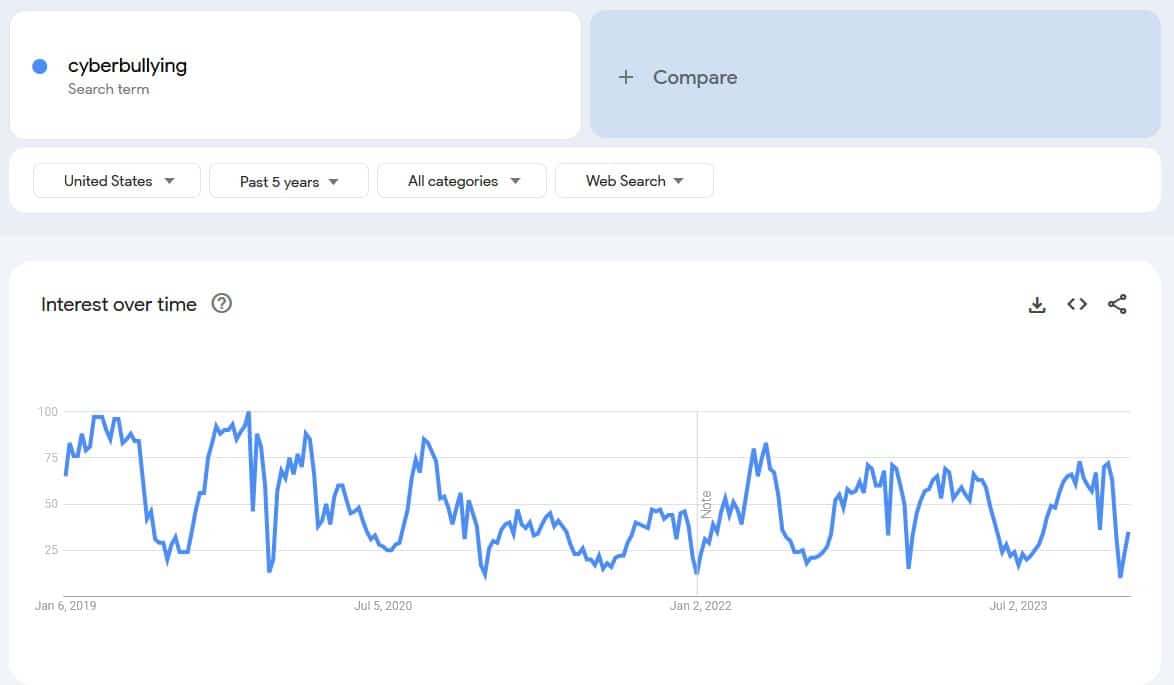
8. Cyberbullying may be contributing to the increase in youth suicides
In the United States, suicide is one of the leading causes of mortality for people between the ages of 10 and 44. According to the CDC, there were 13.7 such incidents per 100,000 citizens in 2021, with rates remaining fairly similar across all regions of the country.
Using the CDC’s online WONDER system, we can tell that there were 23,844 victims of suicide in this demographic that year. Of these, 7,134 victims (29.9 percent) were between the ages of five and 24.
Although the CDC data does not suggest a reason for the increase in suicides, cyberbullying may indeed be part of the equation. A 2022 study from the Lifespan Brain Institute concluded that being a cyberbullying victim corresponds with increased incidence of suicidal thought, though being a perpetrator does not. This mirrors a 2018 study which found that young adults under the age of 25 who were victimized by cyberbullying were twice as likely to commit suicide or self-harm in other ways.
9. Bullying has surprising impacts on identity fraud
It appears bullying has effects beyond self-harm. Javelin Research finds that children who are bullied are 9 times more likely to be the victims of identity fraud as well.
10. Young adults remain split on content moderation
A 2021 study from the UK anti-bullying organization Ditch the Label found that over 40 percent of people under 25 years old aren’t sure whether social media platforms should be more tightly moderated. Around a third would like to see increased moderation, with 15 percent of respondents being against this move.
11. Most young adults believe cyberbullying is not normal or acceptable behavior
Unfortunately, Ditch the Label changes its questions every year, making it difficult to track changes in attitude over time. Still, this does help it cover a wider range of topics. For instance, its 2017 survey found 77% of young adults do not consider bullying to be simply “part of growing up”. Most (62%) also believe hurtful online comments are just as bad as those made offline. And in a nod to the idea that celebrities are still human, 70% strongly disagree with the idea that its ok to send nasty tweets to famous personalities.
All the same, personal perspectives on how to treat others don’t always result in positive behavior. Hypocrisy tends to rule the day, as the Ditch the Label survey also found that 69% of its respondents admitted to doing something abusive to another person online. One study found that adolescents who engaged in cyberbullying were more likely to be perceived as “popular” by their peers.
12. Cyberbullying extends to online gaming, as well
Social media tends to eat up most of the attention related to cyberbullying, but it can occur across any online medium, including online gaming. In one survey, 90 percent of gamers reported experiencing cyberbullying in-game, with racism, hate speech, and extremist content extremely common.
Meanwhile, a survey of over 2,000 adolescents found that over one-third experienced bullying in mobile games. And a 2020 Ditch the Label survey of over 2,500 young adults found 53% reported to be victims of bullying in online gaming environments, while over 70% believe bullying in online games should be taken more seriously.
Online gaming bullying can extend beyond just hurtful words. It can also include the dangerous activity known as swatting, in which perpetrators locate the home address of the victim and make a false criminal complaint to the victim’s local police, who then “send in the SWAT team” as a response. Swatting has resulted in the shooting death of innocent victims, making it a particularly troubling practice more commonly associated with the gaming community.
13. Cell phone bans in school don’t prevent cyberbullying
In early 2019, the National Center for Education Statistics (NCES) released data showing that schools where cell phones were disallowed also had a higher number of principal-reported cases of cyberbullying.
14. Cyberbullying impacts sleeping habits
A 2019 study found teens who were cyberbullied were also more likely to suffer from poor sleep and depression. This finding was echoed in Ditch the Label’s 2020 report, in which 36 percent of respondents reported feeling depressed. Around one in ten respondents to Ofcom’s 2022 media usage study was able to locate information or tools to help them sleep online, but the vast majority either didn’t look or couldn’t find anything useful.
15. Being connected to peers and family helps reduce cyberbullying
According to a 2022 Ofcom study, around 45 percent of British parents trust their child to be responsible about the content they consume online, rather than relying on technical restrictions. Around half of the respondents replied that they checked in with their child about their browsing habits every few weeks, with only five percent having this conversation once and never again.
However, with 46 percent of teens offering help with the internet to relatives every week, there are clearly limits on how much family can help without a better understanding of social media platforms and their protection tools (or lack thereof).
Other research indicates that forming stronger bonds with their kids could be an effective way to help prevent bullying. An online survey of South Australian teens aged 12-17 found that social connectedness significantly helped reduce the impact of cyberbullying.
And considering roughly 64% of students who claimed to have been cyberbullied explained that it negatively impacted both their feelings of safety and ability to learn at school, an increase in social connectedness could make a significant impact on students’ comfort in the classroom.
16. Female and LGTBQ+ cyberbullying victims are common
Girls are almost twice as likely to be victims of cybercrime while boys are more likely to be cyberbullies. There’s significant cross-over between in-person and online bullying. Researchers found 83% of students who had been bullied online in the last 30 days had also been bullied at school. Meanwhile, 69% of students who admitted to bullying others online had also recently bullied others at school.
Research also indicates that those who identify as LGBTQ+ face more significant bullying than those who identify as heterosexual. The consequences of this kind of treatment also lead to an increased rate of suicide among some LGBTQ communities and may result in decreased educational attainment.
- Almost 40 percent of LGBTQ teens were cyberbullied in 2021, compared to 15.9% of their heterosexual peers. (Source: CDC)
- Between 2019 and 2021, Ditch the Label found more than 260 million instances of hate speech online.
- Online transphobic hate speech is now up 28 percent from 2020.
- A larger number of LGBTQ teens (18%) report not attending schools to avoid bullying, compared to 9.7 percent of heterosexual teens. (Source: CDC)
- Black LGTBQ youth are more likely to face mental health issues due to cyberbullying when compared to non-black LGTBQ youth and youth who identify as heterosexual. An American University study of CDC data found 56% of black LGTBQ youth are at risk for depression. (Source: American University)
- American University found 38% had suicidal thoughts within the past year, compared to heterosexual youth. (Source: American University)
- A 2018 study found that LGBTQ youth experienced increased cyber victimization as they aged, while heterosexual youth did not. (Source: Computers in Human Behavior)
- A study of 1,031 adolescents found that sexual orientation strongly correlates with cyberbullying involvement or negative mental health symptoms. (Source: Journal of Child & Adolescent Trauma)
See also: Preventing LGBTQ+ cyberbullying
17. Vulgar words used by social media users could help to identify perpetrators
The International Journal on Adv. Science Engineering IT found Twitter users who regularly use vulgar words in their Tweets are more likely to be behind some form of cyberbullying versus users who avoid the use of vulgar words.
18. The shocking reality of children impersonating others
A Digital Citizenship report from the Cyberbullying Research Centre surveyed 2,500 US students aged 12-17. It showed that 9% of those surveyed admitted to pretending to be someone else online.
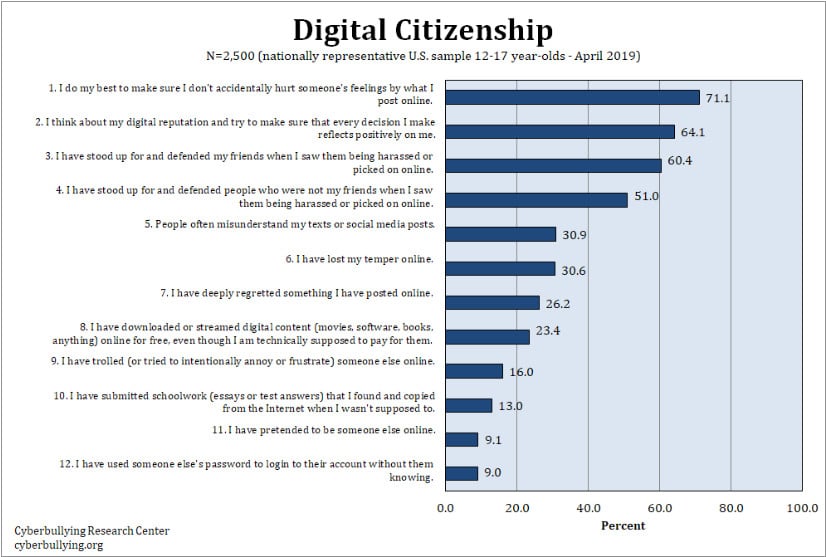
19. More children avoid school because of cyberbullying
While traditionally you’d hear of children skipping school because of physical bullying, a poll by UNICEF found that one in five children haven’t turned up at school due to threats associated with cyberbullying.
20. Over half of the victims of online harassment know the cyberbully
Parents.com (formerly Verywellfamily) reports that over 64% of online harassment victims know the perpetrator from in-person encounters. Even when the cyberbully knows their victim in person, they often resort to upsetting them online by mocking their photos and leaving malicious comments. 25% of respondents say they encountered trolling in video games.
21. YouTube is one of the worst places where cyberbullying occurs
While most parents might consider YouTube a relatively harmless web service for their children to use, the reality is that the comments section under videos is rife with trolling and cyberbullying. Around 79 percent of children who use YouTube have experienced cyberbullying, which leads to stressful interactions on the video platform.
Meanwhile, around 50 percent of young people on Facebook experience cyberbullying. That’s still far too high, but lower than the 64 percent of victims on TikTok and 69 percent on Snapchat.
22. Adults are also victims
While it is vital to protect young people against cyberbullying and cyberstalking, it is also important to remember that this problem also affects many adults. According to PEW research from 2021, over 40% of adults have experienced cyberbullying and harassment online. This behavior often leads to stress and anxiety, which are leading causes for mental health issues.
23. As of 2019, Greece has the lowest cyberbullying rates
According to the Organisation for Economic Co-operation (OECD), Greece has the lowest cyberbullying rates with only 5% of adolescents reporting that they have been victimized by bullying online.
The most significant cyberbullying rates were found in Latvia, where 25% of people reported cyberbullying. Latvia was closely followed by Estonia, Hungary, Ireland, and the United Kingdom where around 20% of adolescents reported cyberbullying.
24. Algorithms can help make people nicer
According to the latest research at Yale Law School, warnings issued automatically by algorithms can help to deter rudeness and cyberbullying.
The researchers looked at posts on Twitter that resulted in a prompt that said, “Want to review this before tweeting?” The study found that users often decided to alter their posts when asked to consider their content.
This reveals that simply being asked to ponder whether a post might be rude, offensive, upsetting, or unnecessary is enough to cause netizens to voluntarily alter their post to make them nicer.
The study even found that being asked to consider a post’s tone helped those social media users remain nicer in subsequent posts too!
25. UK considering rules to allow social media users to block anonymous accounts
In 2022 the UK government announced that it is considering new regulations that would allow users to block contact with any social media user who has not verified their account with a form of ID.
The government hopes that this would allow users to cut themselves off from trolls. However, it could also cause privacy concerns by forcing users to provide an ID in order to be able to communicate with other users on social media.
A need for more broad-reaching and open research
One common theme emerged as we researched various aspects of cyberbullying—a stunning lack of data. This is not to say that research on cyberbullying isn’t there. Even a simple search in research databases will reveal thousands of articles covering the topic in some form. However, most research on cyberbullying is either small in scale or lacking in depth. Most research is also based on surveys, resulting in a large variation in the results from survey to survey.
The Florida Atlantic University study represents one of the best sources of information to date. However, more is needed, including a meta-analysis of the data gathered from many other sources. Until then, publicly available cyberbullying statistics paint an incomplete picture of the ongoing issue.
Past research still holds value
Despite a lack of consistent publicly or easily-accessible data, a plethora of data from before 2015 can still help shed some valuable light on the issue. Past research and statistics reveal where cyberbullying has been and help reflect on why this issue is still a concern today.
Older data on cyberbullying include the following:
- Most teenagers (over 80%) now use a mobile device regularly, opening them up to new avenues for bullying. (Source: Bullying Statistics)
- Half of all young adults have experienced cyberbullying in some form. A further 10-20% reported experiencing it regularly. (Source: Bullying Statistics)
- Cyberbullying and suicide may be linked in some ways. Around 80% of young people who commit suicide have depressive thoughts. Cyberbullying often leads to more suicidal thoughts than traditional bullying. (Source: JAMA Pediatrics)
- Almost 37 percent of kids have been cyberbully victims. Around 30 percent have been victimized more than once. (Source: DoSomething.org)
- 81% of students said they’d be more likely to intervene in cyberbullying if they could do so anonymously. (Source: DoSomething.org)
- A UK survey of more than 10,000 youths discovered that 60% reported witnessing abusive online behavior directed toward another person. (Source: YoungMinds.org)
- The same U.K. survey also discovered that 83% of young adults believe social networks do not do enough to prevent cyberbullying. (Source: DoSomething.org)
Looking for more internet-related stats? Check out our roundup of identity theft stats and facts for 2017-2023, or our Cybercrime statistics which runs to 100+ facts and figures.



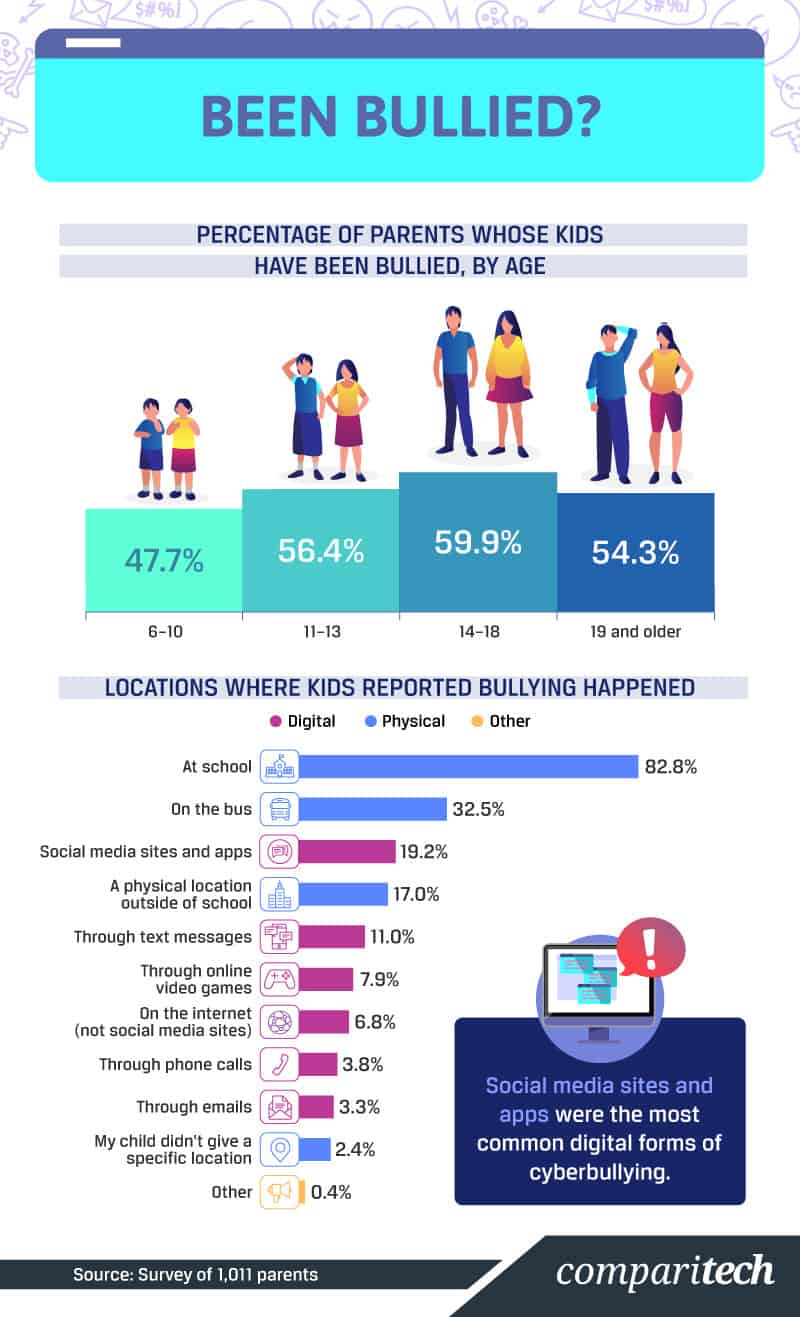
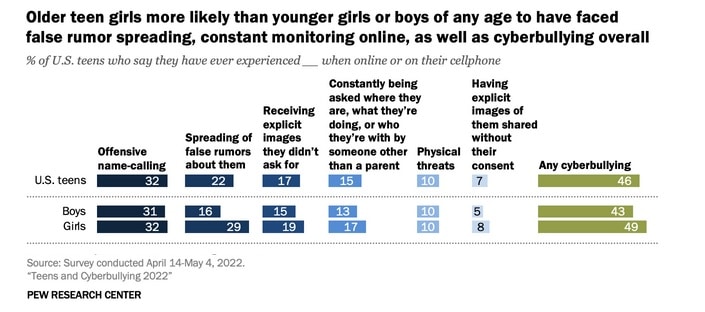
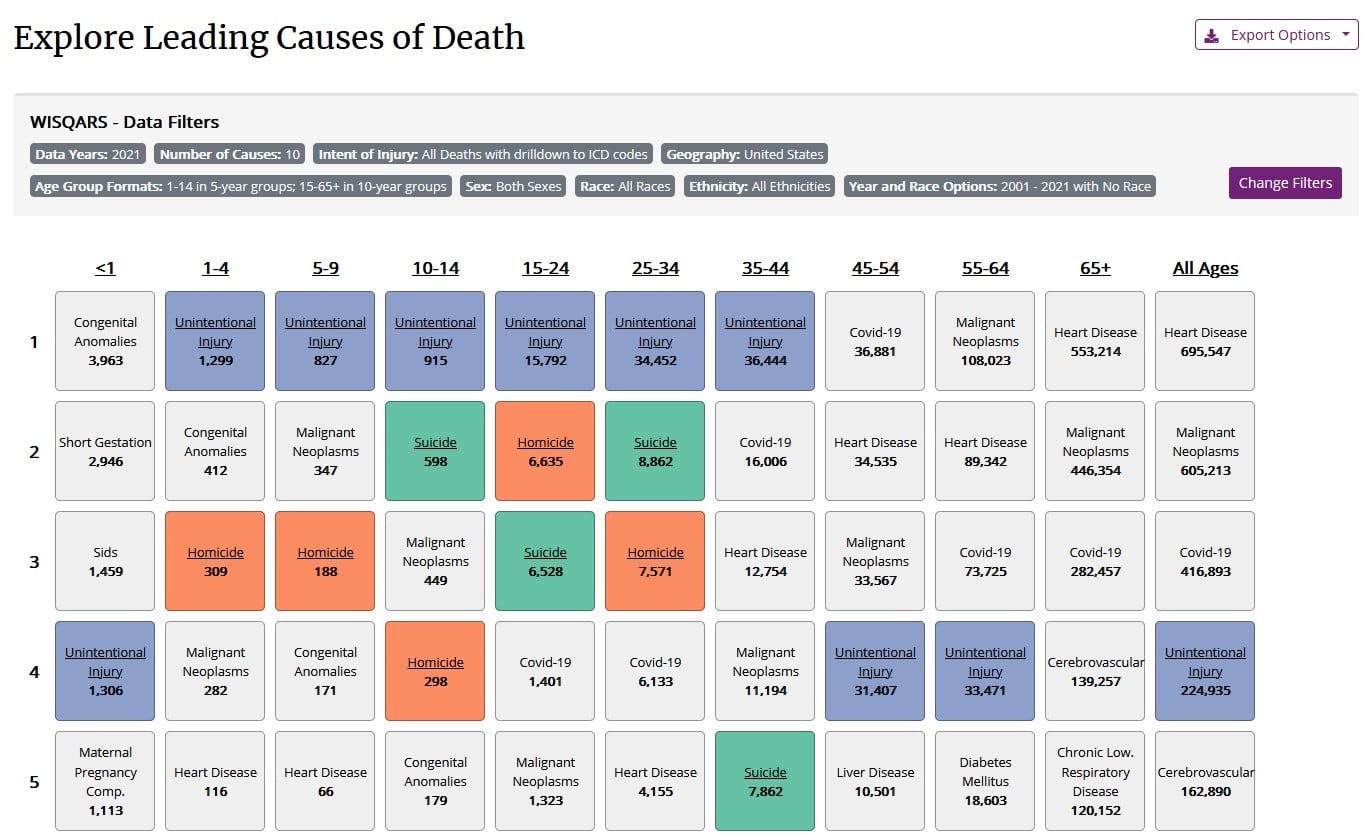
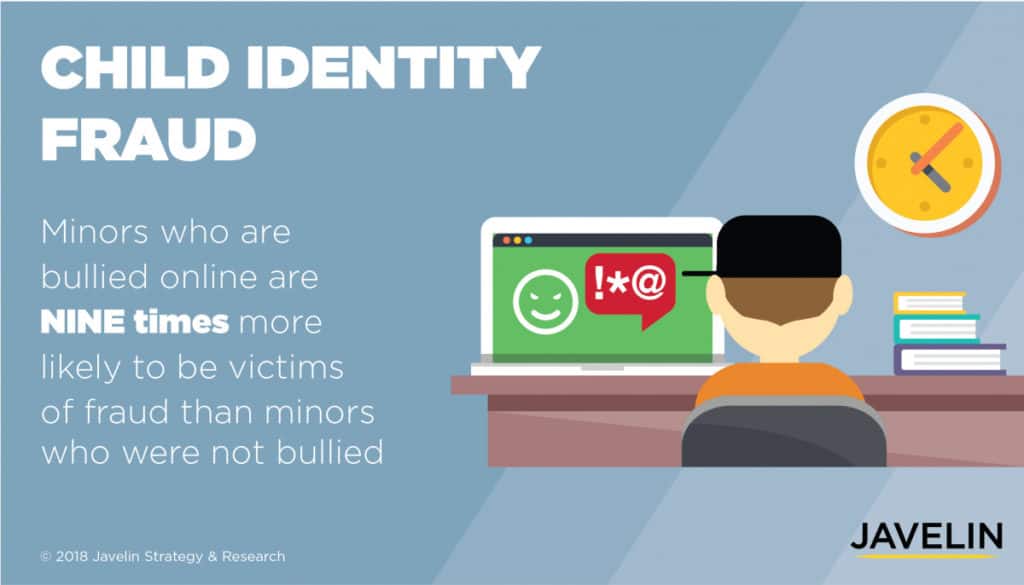
Good post. I’m experiencing a few of these issues as well..
I see that the US has laws against cyberbullying, do you know where I would find those or how often they are actually enforced? Are there any statistics on the number of teens, and maybe even the ages, that are victims of identity theft? Also, are there any statistics on the number of suicides that were due to bullying or cyberbullying? Thanks for the information as well. I think too many people in this world will do anything, no matter who it hurts, just so they can feel better about themselves. I think most bullies are just insecure. I had someone burn my home down because of their insecurities, so I know people are crazy insecure. I just wish I realized it sooner. My son has said some things to me at different times about another person (when he was mad) that could be seriously detrimental to their well-being. I always stop what I am doing and make sure he hears what I have to say and understand the seriousness of the possible consequences to anyone for his words, then tell him the consequences to him if I EVER hear him say/do anything like that again. I think a huge part of putting a stop to bullying of any kind is up to the parent/guardian. If we don’t show our kids how to behave and what is acceptable, how will they know?
Hi Jennifer!
You may have some difficulty finding out how frequently US cyberbullying laws are enforced. The laws are not federal or centralized. They exist separately and unique in different states and municipalities. Data might exist across those states, but it may not be consistent.
You can find some information on the number of people under the age of 16 who are victims of certain types of ID theft, but not all types. For example, the FTC keeps some records on child identity fraud, though it’s not likely representative of exactly how widespread the issue is since it’s based on self-reported data.
Thank you for your personal diligence as a parent.
In the first graph, it shows some white countries. I am currently saying that 15 countries have any anti-cyberbullying programs, but I want to make sure I’m accurate, so what do I say?
Hi! Sorry for the late response.
Our data shows 16 countries have cyberbullying laws in place:
Japan
Spain
Chile
France
Peru
Argentina
Italy
Hungary
South Korea
Mexico
Sweden
Australia
Brazil
Canada
Great Britain
Poland
United States
Another 3 have “partial” laws in place, meaning there’s either been discussion of such laws, or they have laws that cover cyberbullying generally, but don’t specifically mention cyberbullying in the law.
Hungary
China
Saudi Arabia
Hope that helps!
And to answer your other question, the countries that are greyed are countries where no information exists, so your assumption on that is correct.
And in case you get an email, I edited the list a bit as I realized I copied too many rows. It should read:
Japan
Spain
Chile
France
Peru
Argentina
Italy
Hungary
South Korea
Mexico
Sweden
Australia
Brazil
Canada
Great Britain
Poland
United States
(Countries with laws)
And
Hungary
China
Saudi Arabia
(Countries with partial laws)
Thank you so much! This greatly helped me, and will remember to forward your awesome work to others. Do you by chance have any other articles like this?
Glad to be of help! We don’t have too many that would be along a similar topic, but this one might help:
https://www.comparitech.com/internet-providers/technology-internet-addiction/
Hey I was curious, when I quote you from this (and because you used listed sources) do I also have to recite where the information was originally from? Like for example say “your quote here,” source (the source). Or do I just have to put your quote? I’m only 14 and found this paper extremely useful!
Thanks for using our resource!
You have a few avenues you might explore with this.
1. Cite it like you would any other web page, using the proper format for that.
2. Cite the original sources. We’ve listed all of the original sources for each stat/fact listed.
3. Cite it like you would a Wikipedia page (which is consequently basically the same as #1).
The important thing is to cite at all, so I’m glad you’re doing that! I’m not sure whether you’re using APA or MLA, but there are several good resources to help you create the proper citations, including http://www.citationmachine.net/. Best of luck!
I am using this as a source for my annotated bib. research paper, what day was this pulished
Hi Tyrin! Are you using APA citation format? If so, you’ll only need the mostly recent publish date (last update) which is June 22, 2019, and not the original publication date for the post. Additionally, if using APA, make sure to include date accessed!
Thank you! Also can you give me information about the author author, R. Bradley-Andresoiu if you don’t mind?
You can find author bio information for all Comparitech writers (including mine) on the Author’s page of the site:
https://www.comparitech.com/authors/
Great info. Really interesting to see some of these responses and statistics.
I’d really like to use your graphs. May I use it for my academy workshop support? I hardly found these
Thanks!
Any of the graphs you find here can be re-used, just make sure to include proper citation.
I need the info for schol so thanks
Interesting articles!
This is a great article with great numbers to use in an essay! Thank you!
@metoo
We’re happy to help!
Great information! Using some of these statistics for a debate on whether or not cyber bullying should be criminalized!
Glad to be of help!
Very useful for my school essay, thanks!
Glad we could help! As a former teacher, I’m conflicted though. Try not to procrastinate in the future 😉
thx for this i have a school essay so thx
Very glad I could be of help!
Cyber bullying needs to stop no joke the rates are going up